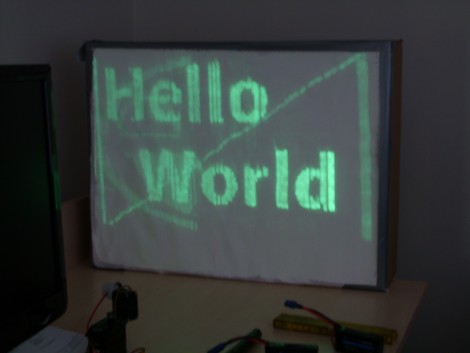
This laser display is persistent thanks to a glow-in-the-dark screen. [Daniel] built it using a Blu-ray laser diode. As the laser dot traverses the screen, it charges the phosphors in the glow material, which stay charged long enough to show a full image.
The laser head is simple enough, two servo motors allow for X and Y axis control. A Micro Maestro 6-channel USB servo controller from Pololu drives the motors, and switches the diode on and off. This board offers .NET control, which [Daniel] uses to feed the graphics data to the unit. Check out the video demonstration below the fold to see a few different images being plotted. It’s shot using a night-vision camera so that you can really see where the laser dot is on the display. It takes time to charge the glow material so speeding up the plotting process could actually reduce the persistent image quality.
This is yet another project that makes you use those geometry and trigonometry skills.
[youtube=http://www.youtube.com/watch?v=akY24gXPyYs&w=470]















Does anyone else see large item 3d printing possibilities with this?
“It takes time to charge the glow material so speeding up the plotting process could actually reduce the persistent image quality.”
use a higher power laser!
i have a 5 or 10mW 445nm laser that makes glow in the dark things light up pretty quick, but then my 50mw 445nm looks practically nuclear instantaneously
nice project, ent… I may borrow this idea for a live audio visualizer…
@jordan, 445nm lasers can be much more powerful than 50mW. A 1W 445nm laser is now common. Also, you can buy a 600mW 405nm diode for approximately the same price as a 1W 445nm diode. I have both, and after comparing them I found that the 405nm diode fluoresces most material far better than 445nm.
Do these phosphors dim fast enough to make a 60 FPS scan attainable? You know, like Cenozoic era cathode ray tubes.
Here’s something VERY weird I discovered many years ago when I got my first laser pointer (cost £35 for what you can now buy for less than £1).
Shining the red laser on a sheet of charged-up glow stars stops it glowing where it’s shone, tried the same with my green laser pointer recently and that also stops it glowing (much quicker because it’s brighter).
Both the red and green lasers make a dark spot or dark line where you shine them on the glowing material.
WTF is going on?
Using servos is unnecessarily slow and clunky when there are cheap Chinese galvos available, as seen here: http://lm741.posterous.com/new-footage
I would use it as a huge oscilloscope!
It even has persistence.
@Haku
Is the dark line permanent (as in, it stays dark untl charged again), or temporary (as in it becomes light again)?
It may just be that the brightness of the laser causes your eye to overcompensate for it, causing dark tracks. I guess you’d notice tho.
You can speed up the scan and simply repeat it over and over again rapidly to get a more even exposure to the image.
That should be the preferred method instead of just going over it once.
Why not just use two lasers and interlace the picture?
@other jordan
derp i meant to say 405nm… 445 is the wavelength I don’t have yet.
if only 1W blues weren’t so expensive…
@Haku:
Here’s my semi educated guess:
A phosphorescent material is charged by absorption of photons, causing electrons to reach higher energy states. This energy state is then reduced first (e.g. thermally) without emission of photons to an intermediary state. From there, it can directly emit the light again (fluorescence), but in rare cases, the electron reaches a different spin state. From this state, the energy is released slower, as the electron needs to undergo another spin change, which is unlikely. The afterglow effect (phosphorescence) is the emission of photons by this process. External factors (heat) increase the speed of the process.
This explains why the lasers cannot charge the material: as monochromatic light it only contains the visible wave length, which is not sufficient to reach the energized state.
Now my guess is, that the light stimulates the discharge of energy from the energized atoms.
@Timmeh, shining the laser on charged glow material makes it stay dark until you charge it up again with ‘normal’ light. It’s not your eyes compensating for the brightness of the laser because I held the laser right on the glow material so you couldn’t see the laser light, then taking it away leaves a dark dot.
@foogoid, that’s an interesting educated guess and it does make sense.
I’m going to have to make a video and post it on YouTube because it’s such a weird phenomena, now where did my sheet of glow stars go…
hmm… replaces this with phosphor painted on glass. Put in a red green and blue fine striped material across the glass. Put in a stencil mask or two. Use three lasers. …. ah ^&%$, just re-invented tv….
:)
I’m curious why a video this terrible and grainy was uploaded at 720p and 1080p.
Hi there, i’ll try so answer some of your questions:
@xeracy
Yes, by all means.
@Roberto
No, it takes aprox. 5 mins to draw an entire frame, video is 8x speed
@Haku
Wow thats cool. if it works i’ll try to implement it as an eraser.
@Jas
Yes it is very slow and clunky, thanks for the link i’ll check it out.
@Hirudinea
Its a money issue, samething goes for Jas’ galvos (i havn’t checked out the pricetag yet)
Two lasers and a smoke machine, yes please :)
Possible Improvements:
Faster and more precise servos
Use a spinning mirror to paint the entire image for x amount of time.
More powerful laser (current laser is 100mW from ebay)
Make the glow paint layer thicker, shorter charge lasts longer (retains the image for longer, reduces fps)
Possible to implement shades, draw the lighter ones first.